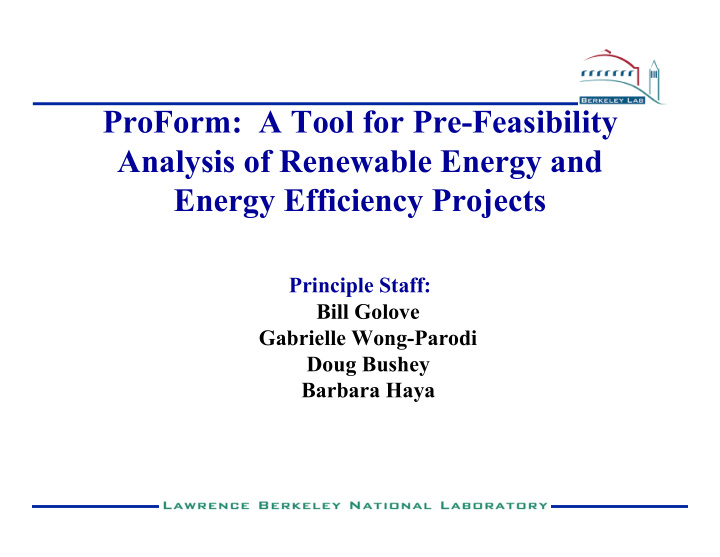



ProForm: A Tool for Pre-Feasibility Analysis of Renewable Energy and Energy Efficiency Projects Principle Staff: Bill Golove Gabrielle Wong-Parodi Doug Bushey Barbara Haya
What is ProForm? • A computational tool that: – Quantifies emission reductions – Calculates the financial impact of the sale of carbon credits on a project • Designed to evaluate renewable energy, fuel switching, co-generation, landfill methane and energy efficiency projects • Available in English and in Spanish
Rationale for the Development of ProForm • Need for a common framework to conduct assessment of clean energy projects (i.e., projects with greenhouse gas reduction benefits) • Lack of familiarity among small entrepreneurs in developing countries with financial analysis/pro- formas • Lack of access among local developers to expensive project analysis software • Requirement for evaluation of the impact of potential revenue from carbon credits under alternative project financing arrangements (additionality)
Who Should Use ProForm? • Small entrepreneurs in developing countries • National climate change/energy and regulatory agencies • Individual/multi-lateral investors and financial institutions • Consultants
Benefits of Proform • Simple, transparent and precise methodology • Lowers project preparation costs • Reduces complexity and subjectivity in the process of estimating financial and environmental benefits. • Can be used both for preparing project proposals and for evaluating project proposals
Types of Projects • Energy efficiency projects that: – Reduce electricity consumption – Reduce fuel consumption – Reduce electricity and fuel consumption • Renewable energy projects that: – Generate and sell electricity to the grid – Generate and use electricity internally • Renewable non-electric projects that displace the use of fuel • Fuel switching projects • Landfill methane gas capture projects • Cogeneration projects
Pre-Feasibility Analysis • ProForm aids the user in evaluating a variety of scenarios – Unlimited, user-defined baseline scenarios – 3 scenario capability built-in • Values for carbon credits • Discount rates – Other financial and technical variables, such as • Loan terms • Electricity price • Capacity factor, etc.
Results • Financial: – Net Present Value – Internal Rate of Return – Cash Flow – Debt Service Coverage Ratio •Emissions reductions: – C, NOx, SOx, PM
State of the Tool • ProForm is a tool in development for a market in development • Financing ProForm – Seed money from the U.S. Department of Energy – Continuing development, distribution, and training funds from USAID • ProForm is distributed free of charge • Training in the use of ProForm will be offered if there is sufficient interest and funding; also customized versions
Types of Partnerships Financing Agencies Logistic Partners USAID NGOs USDOE Consultants Endorsement Partners Development Banks Training and Governmental Agencies Distribution Individual users Multilateral Investors Partners Financial Institutions NGOs Private Companies Industry Researchers Assoc’s Consultants Consultants
ProForm – Baseline Methodology Profile of Baseline Electricity Generation Baseline Technology Baseline Technology Type Fuel * None Selected Generation Technology 1 None Selected None Selected Generation Technology 2 None Selected None Selected Generation Technology 3 None Selected Generation Displaced By Project (% Of Total) * Baseline Technology Type 1 (None Selected) % Baseline Technology Type 2 (None Selected) % Baseline Technology Type 3 (None Selected) % TOTAL - Must Total 100% 0% Transmission And Distribution * Grid Losses % Baseline Technology Type 1 (None Selected) * Energy Conversion Efficiency % Environmental Emissions None Selected - Fuel Carbon Intensity Ton C/GJ000 None Selected - Fuel SOx Intensity -- Optional Ton SOx/GJ000 None Selected - Fuel NOx Intensity -- Optional Ton NOx/GJ000 None Selected - Fuel Particulate Intensity -- Optional Ton PM/GJ000 Renewable Non-Electric Replaces Baseline Electric * Baseline Technology Energy Conversion Efficiency Factor %
Baselines and ProForm Results Project: Small Hydro in Central America Three Baseline Scenarios: -Carbon intensity of current marginal dispatch -Retired diesel brought out of mothballs -Development of Central American grid Avoided Carbon Net Present IRR IRR Baseline Scenarios Emissions Value (without carbon (with carbon (tonnes/y) (US$ 000) credits) credits) I. Current marginal dispatched power 3,560 418 12.2% 14.5% II. Retired diesel plants added 5,560 638 12.2% 15.9% III. Interconnected regional grid 2,780 332 12.2% 14.0%
ProForm Web Site • ProForm version 3.2 is distributed free of charge at: – http://poet.lbl.gov/Proform • Other tools and related publications are available at: – http://eetd.lbl.gov/ea/EA_C_I.html • ProForm v. 4.0 will be available soon!
Recommend
More recommend